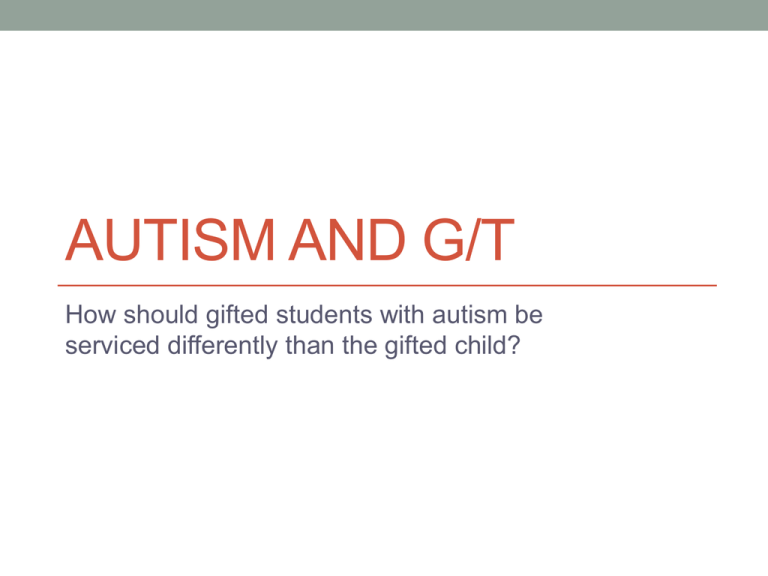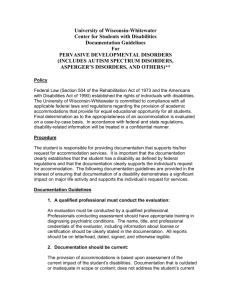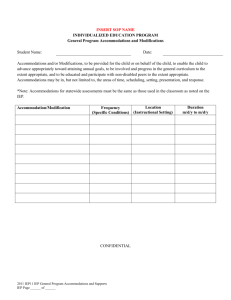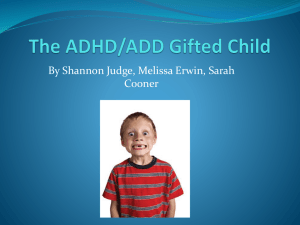Autism Spectrum and Gifted
advertisement

AUTISM AND G/T How should gifted students with autism be serviced differently than the gifted child? Gallagher Characteristics Characteristic GT AS/GT Routines Usually follows routines Low tolerance for routine Social Awareness Know they are different, can reason why Know they are different, poor awareness of why Humor Receives/gives humor Cannot reciprocate humor; does not understand timing Motor Skills Coordinated Motor clumsiness Insight Keen insight Insight (especially social) absent Moral sense Empathy for others and for abstract whole Empathy for abstract whole; difficult with empathy for others Social Interaction Knows how to make friends Unaware of how to establish friendships Knowledge Base Extensive knowledge base, both deep and complex Extensive knowledge base, deep ands sometimes complex Two big problems People focus on accommodations for giftedness only. People focus on accommodations for autism only. We must address both. Teacher behaviors • Be patient! Be flexible! Be positive! Be creative! Be informed! Be outspoken! • Remember to avoid placing too much emphasis solely on giftedness or ASD • Do not take misbehavior personally. Stay calm, be direct, keep a positive tone. • Arrange a “safe person” or “safe-place” so that the students may remove him/herself from a stressful situation. • Allow the student to write down concerns when being verbally argumentative or repetitive. Teacher Behaviors, cont. • Model and teach social skills. Handle teasing immediately. • Avoid using idioms, sarcasm, double meanings, nick- names. • Be as concrete as possible when interacting with the student. • Be aware and sensitive to sensory overstimulation. Consider environmental changes. Teacher Behaviors, cont. • Use visual cues, written words, etc. when teaching abstract concepts. • Always consider multiple ways of presenting an assignment: visual, verbal, physical, etc. • • Have especially kind students be group partners, peer “go-to” helpers. • Do not rely on the student to relay messages to his/her parents. Frequent and accurate communication with parents is essential. Assouline Reading and AS/GT • Children with Asperger's are often hyperlexic (can read complex vocabulary words), but they do not always understand these words. • Children with Asperger’s who are also gifted sometimes understand and comprehend most of the words they read. Assouline Reading accommodations • Allow students to pick books in their area of interest. • Encourage fictional pieces (not just non-fictional pieces) in the chosen area of interest. • Abstract concepts can be difficult. Be aware of this when assigning reading. Students need to maintain confidence. • Focus on enjoyment and comprehension over speed. • Consider pairing students AS/GT students with other GT students. Have them read the same material in the area of interest to develop social skills. Assouline Recommendations to Enhance Math Success • • • • Present advanced level material. Avoid repetition of concepts. Give time for student to process new information. Encourage students to try math concepts outside of their comfort zone. Assouline Accommodating Slower Cognitive Processing Speed Many students diagnosed with AS have a deficit in processing speed. This can be very frustrating since they are not able to quickly express their high verbal capabilities. • Allow adequate time for students to think through your question before having them respond. • Write important facts and deadlines on the board. • Avoid timed tasks. • Emphasize quality over quantity for assignments. • Have students create outlines for larger assignments. • Verbally praise persistence on tasks. Assouline Accommodate difficulties in writing, written, language, and fine motor coordination Since AS students typically have a high vocabulary, teachers will often think that these students will be exceptional in their writing as well. However, the two often don’t align. • Offer a variety of pens and pencils so students can find one that’s most comfortable. • Avoid rapid note taking. Give students handouts of class notes beforehand. • Have students record their response, then form a written response by listening back to the recording. • Use graph paper for math calculations to help with number alignment. Assouline Accommodations for Gifted Students with Autism • • • • • • • Avoid repetition of concepts. Give time for student to process new information. Allow adequate time for students to think through your question before having them respond. Write important facts and deadlines on the board. Avoid timed tasks Offer a variety of pens and pencils so students can find one that’s most comfortable. Avoid rapid note taking. Give students handouts of class notes beforehand. Assouline Recommendations for Supporting Behavioral Difficulties • Behavior problems often occur as a result of stress. Remove student from the source of stress. The student may need to go to a place where he/she feels at ease. • Students may not know what to do during ‘down time’. Find their interests and give specific suggestions to avoid behavior issues. • At times, a behavior intervention plan may be needed. Discuss the finalized guidelines with the student in an explicit way. Consistency with the plan with all staff, situations, and settings is essential. • In addition to verbal cues, visual cues of expected behaviors may be helpful. Assouline Recommendations for Addressing Language and Communication Difficulties Communication with Peers • Try to pair AG/AS student with a peer with similar interests. • Monitor for bullying. AG/AS students may be ‘easy targets’ for bullying, especially since they may not understand teasing. Communication in Class Setting • Speak in a straightforward and direct style. • Have student repeat directions back to you to ensure understanding. • Praise hesitant student when they contribute to class discussions. Assouline Recommendations for Enhancing Social Skills • Lack of social skills can have a negative effect on their academic progress • Use every opportunity to help teach social awareness inside and outside of the classroom. • Explicitly teach social skills and appropriate social interactions. • Help the student increase positive social interactions by taking purposeful steps or specific suggestions. • Example: Make arrangements for the student to sit near a group of students at lunch or free time to allow opportunities for social interaction. • Example: Help the student find other students with similar interests. • Example: Say to student, “After you finish lunch, go ask Heather about the book she is reading”. Bianco Strength-Based Accommodations • Strength-Based Accommodations should be used regardless of the subject area. • Definition: “Instructional strategies that provide students with access to the curriculum based on students’ interests and learning strengths. Strength-based accommodations place emphasis on students’ learning profiles and take their readiness and interests into consideration.” Case Study • Daniel • Age 9 in 4th grade • AS/GT • Highly verbal • Intense vocabulary • Visual learner • Loves entomology, arachnology, and paleontology • How could a teacher use strength-based accommodations when crafting assignments? Bianco Sample activities using strength based accommodations • Compare and contrast two legends that insects in their story. • Listen to “The Flight of the Bumblebee” and write a story to accompany this piece of music. • Create a 3/D display to illustrate the biomechanics of insect flight. • Create a board game about the life cycle of an insect of your choice; teach a friend how to play the game – then play. Bibliography • Assouline, Susan G., Megan Foley Nicpon, Nicholas Colangelo, Matthew O’Brien. “The Paradox of Giftedness and Autism.” The University of Iowa BelinBlank Center. 2008. Web. 18 June 2014. • Bianco, Margarita, Douglas E. Carouthers, and Lydia R. Smiley. “Gifted Students With Asperger Syndrome: Strategies for Strength-Based Programming.” Intervention in School and Clinic. 44(4), March 2009. • Gallagher, Shelagh A. and James J. Gallagher. “Giftedness and Asperger's Syndrome: A New Agenda for Education.” Understanding Our Gifted, 14(2), Winter 2002. Open Space Communications (www.openspacecomm.com) • “Tips for Teaching High Functioning People with Autism.” OASIS@MAAP. Asperbergerssyndrome.org. n.d. Web. 20 June 2014.






